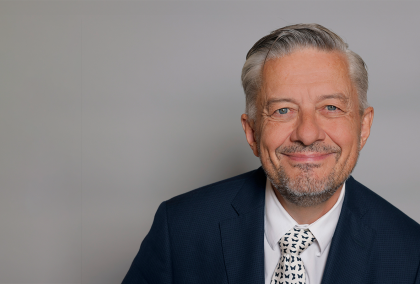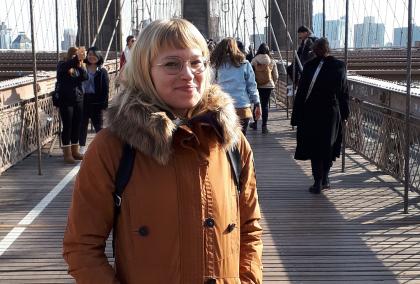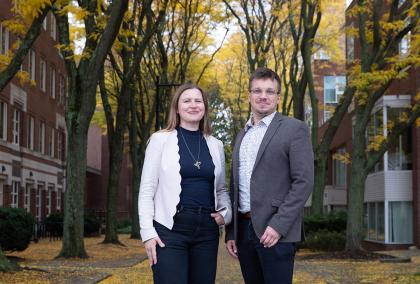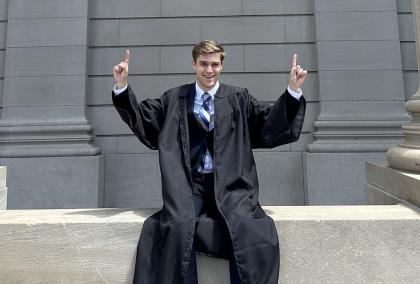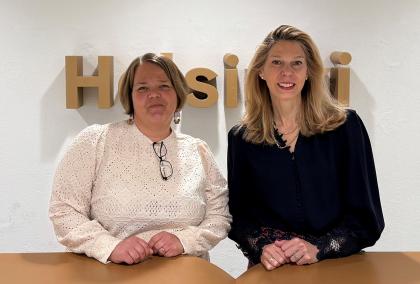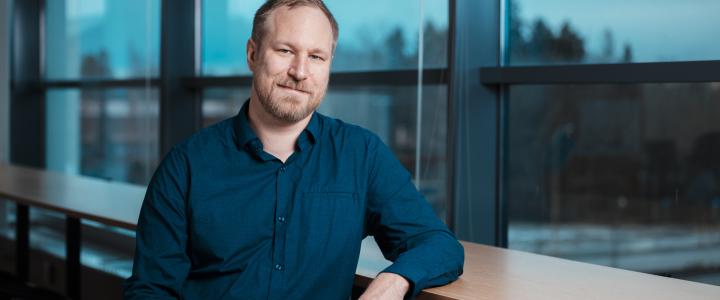

Read what made Jussi apply for an ASLA-Fulbright Grant and what followed from that decision.
My mood was gloomy. A single man stood between my life-long dream and me. And this man also happened to be my nemesis, Professor Matti Uusitupa, Rector of University of Kuopio. As a student representative in the university governing board, we had clashed several times about issues where students and university leadership did not exactly see eye to eye. And now I needed his help.
It all started around a year earlier. I had rushed through my computer science studies in a record time, getting a Master of Science degree and finishing half of my doctoral thesis in just four years. I had found a new love, science, and especially the field of bioinformatics, where an old-school computer nerd like me could use his programming and data analytical skills to solve the secrets of health, disease and the life itself. The realization that I was almost done with all my studies and would soon have to face real-life, was overwhelming. I needed a break, and while doing it, I wanted to see the world.
I started actively seeking for opportunities to spend some time abroad, preferably in an environment where I could also advance my professional skills. I applied for several exchange student programs, mostly based on bilateral agreements with the University of Kuopio and other European universities.
But my real dream was to go to USA. I had seen advertisements about the prestigious Fulbright Program, and even though it sounded scary and grand, I finally gathered up the courage to go to speak with Anitta Etula, director of international relations at the university. Anitta was very encouraging and supportive, and practically demanded that I would apply for the Fulbright scholarship. The cost-share scholarship funded by Saastamoinen Foundation and Fulbright Finland would be a perfect fit for me she explained, and even though I was on early stages of my career, she believed I might have a chance of getting the scholarship. So be it.
The application procedure was quite arduous. I had to get three recommendation letters (and not the type of recommendation letters we Finns are used to write, but the American types, which make you sound like the second coming of Christ), fill out applications, update my CV, and maybe most importantly, come up with a research plan. The plan was a bit tricky, I knew what I wanted (“go to USA, have fun and do great science”), but formulating even somewhat concrete plan on top of that took some effort. Thankfully my PhD supervisor Professor Garry Wong was there to help. Garry, a U.S. citizen himself, and an awesome mentor and my scientific role model, helped me to understand the U.S. university system, and what would be expected from a visiting scholar.
After putting all these things together, I found about the next hurdle. As the scholarship was a cost-share between Fulbright Finland, Saastamoinen Foundation and University of Kuopio, I would need the acceptance of Rector Uusitupa. To get the grant, he would need to nominate and recommend me as the top candidate from the university. If I would have known that beforehand, I would not had applied, as I thought the whole idea would had been futile. But a miracle happened, as maybe sensing a good way of getting rid of a bothersome student, Rector Uusitupa recommended that I would be sent across the Atlantic Ocean, with the scholarship.
It still was far from a done deal. Everyone around me was reminding me that the recommendation did not guarantee anything, as last year, the person recommended by the university was not able to convince the Fulbright selection committee about his applicability, and no one got the grant. During the process, one of my backup plans had worked, and I had gotten an exchange student position in Brussels. I had just moved to Brussels and noticed that two courses of French were not quite enough to get you through medical school curriculum in a French speaking environment, as I got the news that I had advanced to the next round of the Fulbright selection process, namely, the interview.
The timing wasn’t great, as I had just invited some friends to visit me in Brussels, so I literally met them at Brussels airport and left for Finland within an hour. The interview was a bit scary but also very interesting and enlightening. We talked a lot about business, had some laughs, and I felt like I did good. When I was leaving the room, I turned around and said, “I wanted to see how the interview goes first, but as I think it went pretty good, and as I think I now know you guys a bit, I think I can safely offer you some bribes.” I then handed them a box of original Belgian chocolates. The committee members who had been interviewing applicants for the whole day seemed delighted. The next thing I heard from them was to inform that I was awarded an ASLA-Fulbright Graduate Grant for the academic year 2006-2007.
Meeting the other grantees for the first time was a sobering experience. Most of them had everything planned, “I have a longtime collaborator in U.S., he has invited me there, I already have an apartment, and will be spending the time reading these five books that are available on the university library’s second floor. So how about your plans?”, “Uh, to go to U.S. and do some ..science.”
I literally did not have a real plan. But now being a Fulbright scholar, I was in a totally new position to start making arrangements. I had money, backing of U.S. State Department and the fame and glory of a prestigious scholarship. I started to think hard about what I’d like to do and where. After a couple of days of contemplation, my conclusion was, to the heck with it. Why not aim for the top? I started listing all the best bioinformatics labs in the world and contacted their leaders and told them about my background and research ideas.
After a couple of days, I got an invitation to both Stanford and Cold Spring Harbor Labs (research institute near New York, led by Nobel laureate James Watson, one of the discovers of DNA), to groups that at the time were recognized as leaders in the field of bioinformatics. But there was still something that was bothering me. As a part of my PhD research, I had created a software tool that combined genetic data from different sources, and tried to get it published in Bioinformatics, the most prestigious bioinformatics journal. They had turned my manuscript down, but after a couple of months, had released a publication describing very similar, but much inferior tool (at least in my opinion). I was certain that the only reason they’d accepted that paper, was that it originated from Broad Institute, the newly founded joint research institute by Harvard University and Massachusetts Institute of Technology (MIT).
I contacted the research group, told them about my background and research ideas, and informed them (in a polite way) that the tool they had just published sucked, and they need me to fix it. Surprisingly, they did not immediately jump to this great opportunity handed to them by a random student from Finland but agreed on a phone interview. A team of professors and senior scientists from Harvard interviewed me, and it was tough. I think I did ok, as afterwards they asked me to send a portfolio of the software developing work I had done. At least it was not a straight refusal, and I was now able to relax and wait for their decision.
And relax I did. On a Friday night, I went to a pre-Christmas party arranged by my student friends, and enjoyed a several mugs of mulled wine, thinking about all these opportunities and how good life is! Until my phone rang. I answered the phone, and on the other end there was a team manager from MIT, accompanied by a team of senior software developers and technologists, and they wanted to do a technical interview about my skills and previous work. This was all good, but it really was a surprise call, as it was 10 pm on Friday evening in Finland (3 pm in Boston, pretty sure no one there thought about time zones before deciding on calling me) and being surrounded by partying students maybe wasn’t my ideal environment for this type of call. Not sure if it was the mulled wine, but after the call, the next thing I heard from them was to inform me that I was invited to Broad Institute of MIT and Harvard as a visiting scholar.
For a while, I thought about weather. Namely weather in Stanford in California compared to weather in Boston. But the opportunity was too great to miss, the possibility to continue working on similar projects that I had worked for my PhD research, combined with the idea of being in an environment that combines all the best things from Harvard Medical school and MIT, was just amazing. I accepted the invitation, and spent a year in Boston, starting on July 2006.
I have often said that this time was the best time of my life. The work environment was incredible, the resources, the culture, and most of all, the amazing people all made it an unforgettable learning experience to possibilities of science and academia. Working alongside top researchers, Nobel laureates and world-class technical experts really opened my eyes. And even more, when I noticed that I was able to do well in that environment, and those experts also started to turn to me to ask for my help in regard to my expertise. A random student from Finland was thriving at Harvard and MIT.
Besides work, I really enjoyed my time off work as well. I learned to love Boston, the warm Fall nights, walks around the city, spending countless hours in bookshops reading books and drinking coffee. And physical training, I had the opportunity to train combat sports that I was not able to train in Finland, and at the end of my year, was training six times a week, plus running every day, and going to gym and yoga several times a week. During the year, I got to top physical and mental shape. It really was a year that transformed me mentally, physically, and professionally.
After my visit that in the end lasted 13 months, I became a research affiliate at the Broad Institute, and visited them a couple of months each year for the next five years. Those trips where great refreshers from my routine work, and always reminded about the year that was become the best year of my life, and that would have not been possible without the support of the Fulbright and Saastamoinen foundations. And not to forget about my nemesis, Rector Uusitupa. After returning from the U.S., he offered me a joint research position in his research group, which I happily accepted.
Since then, I have tried in many ways to share the learnings, connections, and experiences I got during that year.
I have taught hundreds of students, co-founded technology startups, lead my own research group in the university, and participated in dozens of research projects that have produced huge amounts of openly available scientific knowledge and tools. Through life’s mysterious ways, I now lead bioinformatics technology teams in one of the biggest US based diagnostics companies, helping hundreds of thousand of rare disease patients each year to get answers and better treatments. My teams are spread across Finland and USA, continuing the cross-Atlantic collaboration that is in the heart of the founding principles of ASLA-Fulbright scholarships. I truly believe that none of this would have happened without The Year.
Read the whole Fulbright Finland News magazine 1/2022!
